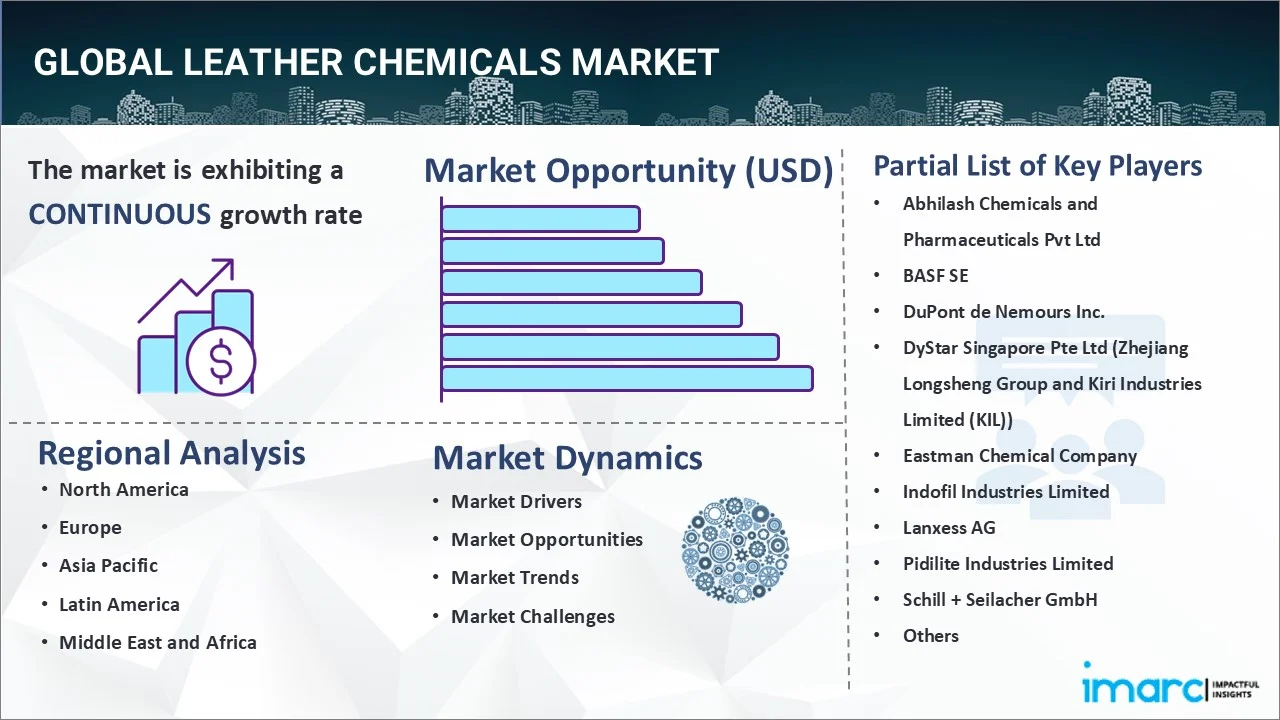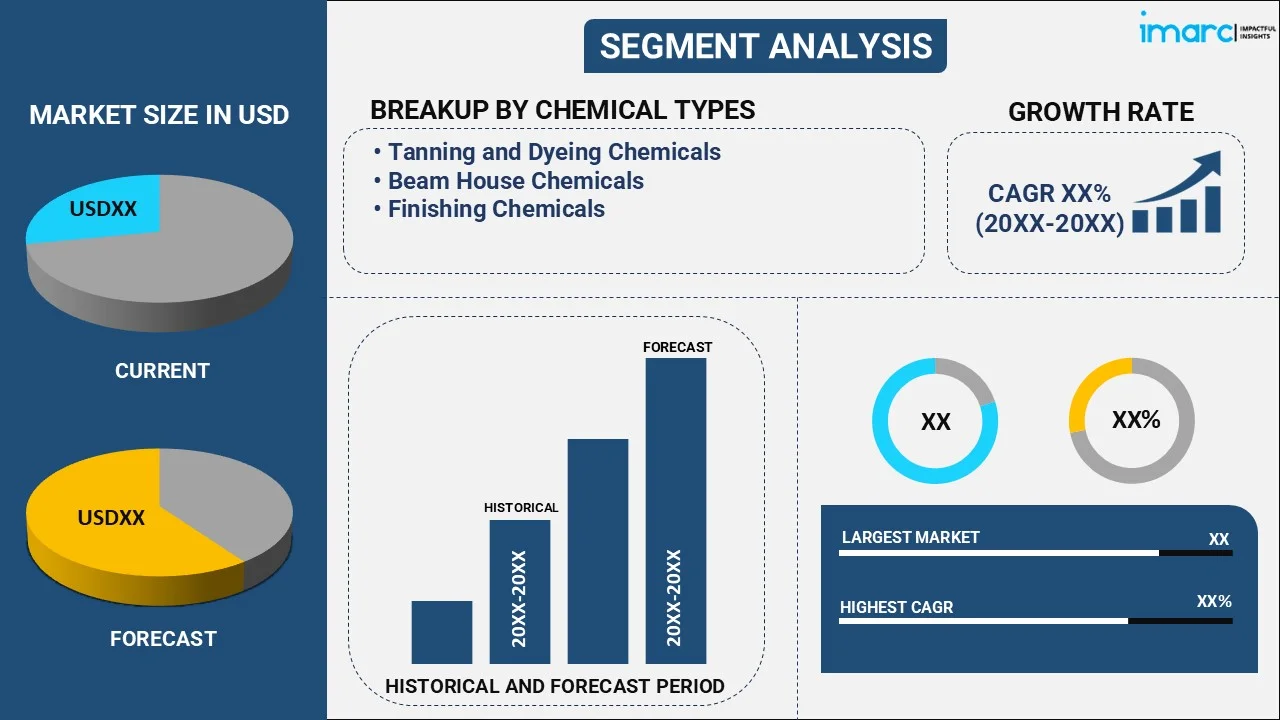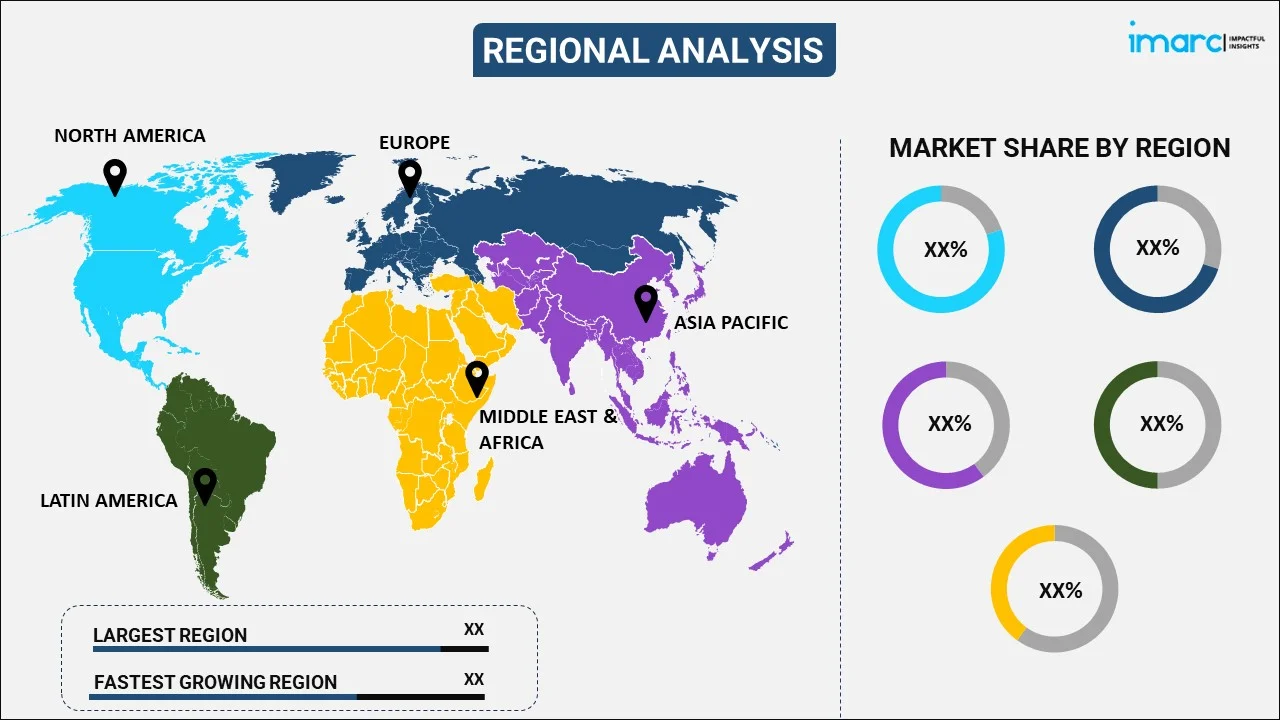
Leather Chemicals Market Report by Chemical Type (Tanning and Dyeing Chemicals, Beam House Chemicals, Finishing Chemicals), Product (Biocides, Surfactants, Chromium Sulfate, Polyurethane Resins, Sodium Bicarbonate, and Others), End User (Footwear, Furniture, Automotive, Textile, and Others), and Region 2025-2033
Leather Chemicals Market Size:
The global leather chemicals market size reached USD 9.7 Billion in 2024. Looking forward, IMARC Group expects the market to reach USD 15.3 Billion by 2033, exhibiting a growth rate (CAGR) of 5.2% during 2025-2033. The market is driven by the increasing demand from the automotive, footwear, fashion, and furniture industries, rapid advancements in leather processing technologies, and a growing preference for sustainable and eco-friendly leather products, leading to a robust market expansion with diverse applications across various sectors.
|
Report Attribute
|
Key Statistics
|
|---|---|
|
Base Year
|
2024
|
|
Forecast Years
|
2025-2033
|
|
Historical Years
|
2019-2024
|
|
Market Size in 2024
|
USD 9.7 Billion |
|
Market Forecast in 2033
|
USD 15.3 Billion |
| Market Growth Rate 2025-2033 | 5.2% |
Leather Chemicals Market Analysis:
- Major Market Drivers: The desire for premium, long-lasting, and visually beautiful leather interiors is driving the demand for leather chemicals in the automobile sector. Additionally, the interest in the product used for tanning, dyeing, and finishing operations is motivated by the expansion of the footwear sector and the growing needs of consumers for long-lasting and fashionable leather shoes. The market for innovative leather chemicals is likewise influenced by the growth of the fashion and clothing sectors, where upscale firms are looking for novel leather treatments for their high-end items.
- Key Market Trends: There is a noticeable shift toward environmentally responsible and sustainable methods of producing leather, which is resulting in the creation and use of green leather chemicals. Furthermore, the market is changing due to swift technical developments in the leather processing industry, which include new chemical formulations with better performance and less environmental effects.
- Geographical Trends: Asia Pacific is the largest regional market, with major leather-producing nations like China, India, and Vietnam dominating it. The industry is growing because of supportive regulations and a strong manufacturing base. Other regions are also seeing growth due to increased engagement in sports and outdoor activities, higher disposable income, and an expanding textile market.
- Competitive Landscape: Some of the major market players in the leather chemicals industry include Abhilash Chemicals and Pharmaceuticals Pvt Ltd, BASF SE, DuPont de Nemours Inc., DyStar Singapore Pte Ltd (Zhejiang Longsheng Group and Kiri Industries Limited (KIL)), Eastman Chemical Company, Indofil Industries Limited, Lanxess AG, Pidilite Industries Limited, Schill + Seilacher GmbH, Stahl Holdings B.V., TFL Ledertechnik GmbH, and Zschimmer & Schwarz Chemie GmbH., among many others.
- Challenges and Opportunities: Environmental restrictions and the necessity for sustainable production processes present hurdles for this industry, which is encouraging enterprises to develop innovative eco-friendly solutions. Also, opportunities may be found in the increasing need for specialized and high-performance products in a range of industries, along with the possibility of expanding into new regions where there is a growing consumer demand for leather goods.

Leather Chemicals Market Trends:
Increasing Product Demand in the Automotive Industry
The automotive industry is one of the largest consumers of leather chemicals, which is one of the main drivers that is boosting the market growth. Leather is a preferred material for car interiors because of its durability, comfort, and aesthetic appeal. The automotive industry is expanding continuously, particularly in emerging economies, which is creating the demand for high-quality leather interiors. China exported 2.1 million vehicles between January and September 2022, a hike of 55% compared with 2021. Also, 85.4 million motor vehicles were produced around the world in the same year, which is an increase of 5.7% compared to 2021. This trend is supported by a rising middle class and higher disposable incomes, leading to greater car ownership and a move towards premium vehicle features. Leather chemicals play an important role in the production process to make sure that the leather used in vehicles meets stringent quality and performance standards. They are essential in tanning, dyeing, and finishing processes to better the durability, appearance, and feel of automotive leather.
Growth in the Footwear Industry
The leather chemical market is largely motivated by the footwear sector owing to the high quality, comfort, and durability, its offers in making shoes. It is anticipated that the footwear industry will expand quickly, reaching US$ 332.3 billion by 2032. As customer tastes and fashion trends change in favor of attractive and long-lasting footwear, there is an increasing need for leather and leather chemicals. A variety of leather chemicals are used in this industry for tanning, dyeing, and finishing procedures to make shoes that live up to consumer standards for style and quality. In addition, sports and outdoor activities are becoming more and more popular, which has increased demand for specialty footwear that uses leather because of its superior performance characteristics. This has created a demand for products that give performance-enhancing qualities in this industry. In 2022, a report by the Sports & Fitness Industry Association (SFIA), a US-based industry association, found that 237 million US citizens took part in at least one sport, marking a 9.2% increase from 2017 and a 1.9% rise from 2021. This data has highlighted the need for sports shoes that use leather as a key material to better the shoe's performance.
Expansion of the Fashion and Apparel Industry
Leather and leather chemicals are used in the fashion and apparel industry. Leather garments, accessories, and bags are highly sought after for their premium quality, durability, and luxurious appeal. The rising disposable incomes and changing fashion trends, are majorly contributing to the demand for this product. The European household income per capita increased by 2.6 % between 2013 and 2021. Along with Europe, India's per capita disposable income grew by 8% in FY24 and 13.3% in FY23. This hike has created a demand for high-quality and premium leather items. High-end fashion brands and designers are consistently seeking innovative leather treatments and finishes to create unique and attractive products. This demand for novelty and exclusivity drives the need for advanced leather chemicals that offer diverse finishes, colors, and textures.
Leather Chemicals Market Segmentation:
IMARC Group provides an analysis of the key trends in each segment of the market, along with forecasts at the global, regional, and country levels for 2025-2033. Our report has categorized the market based on chemical type, product, and end user.
Breakup by Chemical Type:

- Tanning and Dyeing Chemicals
- Beam House Chemicals
- Finishing Chemicals
Tanning and dyeing chemicals accounts for the majority of the market share
The report has provided a detailed breakup and analysis of the market based on the chemical type. This includes tanning and dyeing chemicals, beam house chemicals, and finishing chemicals. According to the report, tanning and dyeing chemicals represented the largest segment.
As per the leather chemical market trends and analysis, the tanning and dyeing chemicals segment represented the largest market share as they are essential in transforming raw hides into durable and flexible leather. Tanning chemicals, including chrome, vegetable, and synthetic tanning agents, provide leather with resistance to decomposition and enhance its physical properties. Dyeing chemicals, on the other hand, impart desired colors and aesthetic finishes to leather products, making them appealing for various applications such as automotive interiors, footwear, fashion, and furniture. Moreover, the growing demand for high-quality, aesthetically pleasing, and durable leather, boosting the need for advancements in chemical formulations that offer improved performance and environmental sustainability, is fostering the leather chemicals market share.
Breakup by Product:
- Biocides
- Surfactants
- Chromium Sulfate
- Polyurethane Resins
- Sodium Bicarbonate
- Others
Polyurethane resins hold the largest share of the industry
A detailed breakup and analysis of the market based on the product have also been provided in the report. This includes biocides, surfactants, chromium sulfate, polyurethane resins, sodium bicarbonate, and others. According to the report, polyurethane resins accounted for the largest market share.
Based on the leather chemicals market forecast and outlook, polyurethane resins accounted for the largest market share. They are widely used in the leather industry due to their exceptional properties, such as high flexibility, abrasion resistance, and excellent adhesion. These resins are crucial in producing synthetic leather, providing a durable and versatile alternative to natural leather. Moreover, their growing application in various industries, including automotive, footwear, fashion, and furniture, for coatings, finishes, and adhesives to enhance the performance and appearance of leather products is bolstering the leather chemicals market growth.
Breakup by End User:
- Footwear
- Furniture
- Automotive
- Textile
- Others
Footwear represents the leading market segment
The report has provided a detailed breakup and analysis of the market based on the end user. This includes footwear, furniture, automotive, textile, and others. According to the report, footwear represented the largest segment.
According to the leather chemicals market report and overview, the footwear segment accounted for the largest market share as they extensively utilize leather chemicals in various processes, including tanning, dyeing, and finishing, to produce high-quality leather shoes. Along with this, the growing demand for leather footwear, driven by rising disposable incomes, fashion trends, and the popularity of sports and outdoor activities, is positively impacting the demand for leather chemicals. They enhance the aesthetic appeal and functional properties of footwear, making them more resistant to wear and tear while ensuring a premium look and feel.
Breakup by Region:

- North America
- United States
- Canada
- Asia-Pacific
- China
- Japan
- India
- South Korea
- Australia
- Indonesia
- Others
- Europe
- Germany
- France
- United Kingdom
- Italy
- Spain
- Russia
- Others
- Latin America
- Brazil
- Mexico
- Others
- Middle East and Africa
Asia Pacific leads the market, accounting for the largest leather chemicals market share
The report has also provided a comprehensive analysis of all the major regional markets, which include North America (the United States and Canada); Asia Pacific (China, Japan, India, South Korea, Australia, Indonesia, and others); Europe (Germany, France, the United Kingdom, Italy, Spain, Russia, and others); Latin America (Brazil, Mexico, and others); and the Middle East and Africa. According to the report, Asia Pacific represents the largest regional market for leather chemicals.
Asia Pacific represented the largest market for the leather chemicals industry due to its robust leather manufacturing industry. Moreover, the presence of major producers and exporters of leather products, including footwear, garments, and accessories, which require extensive use of leather chemicals, is fueling the market growth. Besides this, the growth of the automotive and furniture industries in the region, propelling the demand for high-quality leather, is boosting the leather chemicals market revenue. Additionally, the increasing urbanization and rising disposable incomes in the region that contribute to the growing consumer demand for leather products are driving the market growth.
Competitive Landscape:
- The market research report has also provided a comprehensive analysis of the competitive landscape in the market. Detailed profiles of all major companies have also been provided. Some of the major market players in the leather chemicals industry include Abhilash Chemicals and Pharmaceuticals Pvt Ltd, BASF SE, DuPont de Nemours Inc., DyStar Singapore Pte Ltd (Zhejiang Longsheng Group and Kiri Industries Limited (KIL)), Eastman Chemical Company, Indofil Industries Limited, Lanxess AG, Pidilite Industries Limited, Schill + Seilacher GmbH, Stahl Holdings B.V., TFL Ledertechnik GmbH, Zschimmer & Schwarz Chemie GmbH., etc.
(Please note that this is only a partial list of the key players, and the complete list is provided in the report.)
- The top companies in the leather chemicals market are focusing on innovation and sustainability to maintain a competitive edge. They are investing in research and development (R&D) to create advanced leather chemicals that enhance performance and reduce environmental impact. These innovations include eco-friendly tanning agents and water-based finishing chemicals that meet stringent environmental regulations and consumer preferences for sustainable products, which in turn is positively impacting the leather chemicals market’s recent opportunities and developments. Additionally, they are expanding their production capacities and strengthening their global distribution networks to cater to the growing demand from various end-user industries, such as automotive, footwear, and fashion. Moreover, leading players are forming strategic collaborations and acquisitions to broaden their product portfolios and market reach. For instance, collaborations with leather manufacturers and fashion brands help in developing customized solutions that meet specific industry requirements.
Leather Chemicals Market News:
- In January 2024, Pidilite Industries Limited partnered with Italy-based Syn-Bios, known for R&D and global marketing in the leather tanning industry. In this collaboration, Pidilite Industries Limited will handle sales and distribution of Syn-Bios products in India, Sri Lanka, Bangladesh, Nepal, and Vietnam. Both companies will also engage in technical collaboration to offer comprehensive solutions for the leather Industry.
- In June 2023, Zschimmer & Schwarz acquired 100% of the Samia’s shares after holding a majority stake of 60% since 2019. Samia is thus a wholly owned subsidiary of the Lahnstein-based family business. The bundled resources and know-how of Samia in the field of leather auxiliaries will be used to open up new international markets.
Leather Chemicals Market Report Scope:
| Report Features | Details |
|---|---|
| Base Year of the Analysis | 2024 |
| Historical Period | 2019-2024 |
| Forecast Period | 2025-2033 |
| Units | Billion USD |
| Scope of the Report | Exploration of Historical Trends and Market Outlook, Industry Catalysts and Challenges, Segment-Wise Historical and Future Market Assessment:
|
| Chemical Types Covered | Tanning and Dyeing Chemicals, Beam House Chemicals, Finishing Chemicals |
| Products Covered | Biocides, Surfactants, Chromium Sulfate, Polyurethane Resins, Sodium Bicarbonate, Others |
| End Users Covered | Footwear, Furniture, Automotive, Textile, Others |
| Regions Covered | Asia Pacific, Europe, North America, Latin America, Middle East and Africa |
| Countries Covered | United States, Canada, Germany, France, United Kingdom, Italy, Spain, Russia, China, Japan, India, South Korea, Australia, Indonesia, Brazil, Mexico |
| Companies Covered | Abhilash Chemicals and Pharmaceuticals Pvt Ltd, BASF SE, DuPont de Nemours Inc., DyStar Singapore Pte Ltd (Zhejiang Longsheng Group and Kiri Industries Limited (KIL)), Eastman Chemical Company, Indofil Industries Limited, Lanxess AG, Pidilite Industries Limited, Schill + Seilacher GmbH, Stahl Holdings B.V., TFL Ledertechnik GmbH, Zschimmer & Schwarz Chemie GmbH., etc. |
| Customization Scope | 10% Free Customization |
| Post-Sale Analyst Support | 10-12 Weeks |
| Delivery Format | PDF and Excel through Email (We can also provide the editable version of the report in PPT/Word format on special request) |
Key Benefits for Stakeholders:
- IMARC’s industry report offers a comprehensive quantitative analysis of various market segments, historical and current market trends, market forecasts, and dynamics of the leather chemicals market from 2019-2033.
- The research report provides the latest information on the market drivers, challenges, and opportunities in the global leather chemicals market.
- The study maps the leading, as well as the fastest-growing, regional markets. It further enables stakeholders to identify the key country-level markets within each region.
- Porter's five forces analysis assists stakeholders in assessing the impact of new entrants, competitive rivalry, supplier power, buyer power, and the threat of substitution. It helps stakeholders to analyze the level of competition within the leather chemicals industry and its attractiveness.
- The competitive landscape allows stakeholders to understand their competitive environment and provides insight into the current positions of key players in the market.
Key Questions Answered in This Report
The global leather chemicals market was valued at USD 9.7 Billion in 2024.
We expect the global leather chemicals market to exhibit a CAGR of 5.2% during 2025-2033.
The growing utilization of leather chemicals across the footwear and textile industries in improving adhesiveness and smoothness of leather, while preventing the damage caused by microorganisms, is primarily driving the global leather chemicals market.
The sudden outbreak of the COVID-19 pandemic had led to the implementation of stringent lockdown regulations across several nations resulting in temporary closure of numerous end-use industries for leather chemicals.
Based on the chemicals type, the global leather chemicals market can be segmented into tanning and dyeing chemicals, beam house chemicals, and finishing chemicals. Currently, tanning and dyeing chemicals hold the majority of the total market share.
Based on the product, the global leather chemicals market has been divided into biocides, surfactants, chromium sulfate, polyurethane resins, sodium bicarbonate, and others. Among these, polyurethane resins exhibit a clear dominance in the market.
Based on the end user, the global leather chemicals market can be categorized into footwear, furniture, automotive, textile, and others. Currently, footwear accounts for the largest market share.
On a regional level, the market has been classified into North America, Asia-Pacific, Europe, Latin America, and Middle East and Africa, where Asia-Pacific currently dominates the global market.
Some of the major players in the global leather chemicals market include Abhilash Chemicals and Pharmaceuticals Pvt Ltd, BASF SE, DuPont de Nemours Inc., DyStar Singapore Pte Ltd (Zhejiang Longsheng Group and Kiri Industries Limited (KIL)), Eastman Chemical Company, Indofil Industries Limited, Lanxess AG, Pidilite Industries Limited, Schill + Seilacher GmbH, Stahl Holdings B.V., TFL Ledertechnik GmbH, and Zschimmer & Schwarz Chemie GmbH.
Need more help?
- Speak to our experienced analysts for insights on the current market scenarios.
- Include additional segments and countries to customize the report as per your requirement.
- Gain an unparalleled competitive advantage in your domain by understanding how to utilize the report and positively impacting your operations and revenue.
- For further assistance, please connect with our analysts.
 Inquire Before Buying
Inquire Before Buying
 Speak to an Analyst
Speak to an Analyst
 Request Brochure
Request Brochure
 Request Customization
Request Customization




.webp)




.webp)












